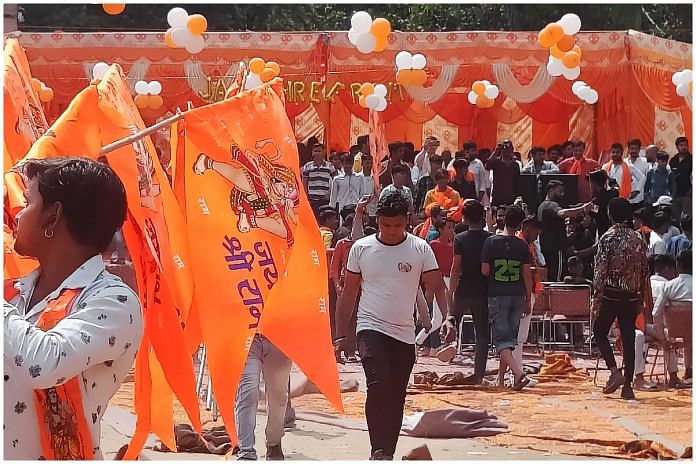Ram Navami, which is a celebration of the birth of Hindu God Ram, is usually marked by prayer, fasting and fevered processions by ardent devotees. However, in recent years, these joyous festivities have been marred by incidents of rioting. This year’s Ram Navami processions witnessed violence in Bihar, West Bengal, Gujarat, Jharkhand, and Maharashtra, while Odisha reported violence during Hanuman Jayanti celebrations. So what lies at the heart of this problem? It’s the Indian habit of calling some neighbourhoods ‘Muslim areas’.
As the threat of communal violence looms large on these processions, we must analyse and solve the problem in an honest and comprehensive manner, considering all perspectives.
History of communal violence in India
We need to examine available data to determine whether violence during Ram Navami is a recent occurrence. While academic research on the subject is limited, scholars Ashutosh Varshney and Steven Wilkinson provide a comprehensive database of communal riots in India from 1950 to 1995. According to The Indian Express’ analysis of this dataset, only nine of the 1,192 riots that occurred during this period were related to Ram Navami – less than 0.01 per cent of all riots. These nine upheavals were recorded in Jharkhand, Maharashtra, Odisha, Gujarat, and Uttar Pradesh. Jharkhand witnessed one of the first major incidents of violence on the occasion of Ram Navami — in 1979, a clash in Jamshedpur claimed the lives of 116 people. Therefore, we can’t say these clashes are a recent phenomenon.
The pattern of Ram Navami riots in India shows that authorities have often denied permission for the procession to pass through Muslim-majority areas. This was evident in Jamshedpur in 1978, where the Rashtriya Swayamsevak Sangh (RSS) had planned a Ram Navami procession from the Adivasi neighbourhood of Dimna Basti. However, the procession’s intended route passed through Sabirnagar, a Muslim area, which made the authorities refuse permission for the rally. The RSS didn’t accept the administration’s suggestion to avoid Sabirnagar and continued its campaign for permission for a year. The following year, the rally proceeded through Sabirnagar, and clashes erupted between Hindus and Muslims, resulting in the death of 116 people. In Delhi this year, the city saw 52 Ram Navami processions, with the one on 30 March taken out by Hindu groups despite police’s denial of permission.
Also read: Muslim intellectuals defend madrasas, but their kids don’t go there. Only poor, Pasmandas do
Why are Muslim areas off-limits?
The RSS and a section of the majority use the argument that Hindus are denied the freedom to carry out processions in their own country. But others argue that allowing the these religious processions to pass through Muslim-majority areas would threaten the safety and security of the Muslim community and cause insecurity and fear. They argue that labelling a particular locality or neighbourhood as a “Muslim area” further perpetuates communal divide and reinforces the notion of Hindus versus Muslims.
The root of the problem seems to lie in tribalism. The RSS calling India “Hindu’s land” can be interpreted as promoting majority domination, suggesting that the country belongs only to Hindus. But referring to Muslim-populated areas as “Muslim areas” and expecting Hindus not to hold processions there also adds to the problem. Every year, Muslims take out the Taziya procession during Muharram, which pass through several localities peacefully.
The question then arises is why some areas are deemed off-limits for Hindu festivities while Muslims celebrate Islam in public, whether it is performing namaz or taking out religious processions.
What stakeholders must do is work together to prevent such recurring violence. This requires a multifaceted approach by the government, civil society organisations, religious leaders, and common citizens. The Centre must take steps to maintain law and order and ensure that those responsible for instigating violence are brought to justice. Hate speech and incitement of violence should have strict legal consequences. The government must also increase police presence in potentially volatile areas and improve socioeconomic conditions to address underlying grievances that can lead to violence.
At the same time, citizens have a crucial role to play in preventing violence during religious processions. They must refrain from engaging in activities that may cause disturbance and report any suspicious activities to the authorities. They must also be willing to engage in dialogue with people from different communities and promote a culture of mutual respect and understanding. Repeated disturbances during festivals like Ram Navami, which should be celebrated in the spirit of unity and brotherhood, should concern everyone.
Amana Begam Ansari is a columnist and TV news panelist. She runs a weekly YouTube show called ‘India This Week by Amana and Khalid’. She tweets @Amana_Ansari. Views are personal.
(Edited by Zoya Bhatti)



